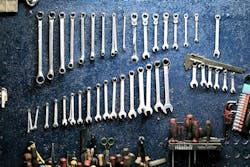SHOP STATS: Mevert Automotive & Tire Center Location: Steeleville, Ill. Operator: Matt Mevert Average Monthly Car Count: 200 Staff Size: 9 Shop Size: 6,200 square feet Annual Revenue: $1 million
Did you know the way your shop is set up can make a huge impact on the business’s revenue? When Matt Mevert, owner of Mevert Automotive and Tire Center in Steeleville Ill., decided to invest in a new shop, he hoped for at least a 15 percent increase in business. To his surprise, he was shocked when revenue increased by over 30 percent. And it wasn’t due to an increase in the shop’s size—his old and new shop were both 5,000 square feet. No, it was his emphasis on the shop’s flow that helped get him there.
Mevert discusses the trials and tribulations that led him to create a blueprint plan for his new operation.
The Backstory
In high school, Mevert worked part-time as a technician at Steeleville’s Chrysler dealership. After graduating high school and going off to the air force, he came home looking to go back to his former tech position. Unfortunately, the dealership didn’t have any open positions, but, luckily, his dad encouraged him to open up his own independent shop.
Mevert started out in an overgrown, two-bay garage adjacent to his father’s welding shop. And after three years in that location, he built a 5,000-square-foot shop in 1997. But after a couple years, the shop plateaued at $250,000 in annual sales. With this, Mevert made a commitment to grow his business’s sales.
The Problem
Mevert followed through on his commitment, growing from $250,000 to $700,000 by 2014—increasing revenue by around $65,000 each year. However, the shop plateaued once again for three solid years. The reason? Mevert says they’d outgrown their current location once again, mainly because the shop’s layout wasn’t efficient, both inside and outside of the shop.
“In the facility we were in, we were being limited with bay layout and space, and our parking area at the old location caused us some issues,” Mevert says. “We had nearly the same amount of square footage, but we had half of the bay space because of the way the building was laid out.”
Inside the shop, the service advisor’s desk was located way off to the side because there wasn’t enough space for two full-time service advisors and a waiting room in one—a lot of customers couldn’t even find where it was sometimes.
“There was a disconnect between the shop and where the service advisors were,” Mevert says.
Outside of the shop was a whole other story. With not enough parking for customers in the first place, there also wasn’t a place to put the cars that were about to be serviced; it was all intermixed.
Not only were the parking lot and staging customer vehicles a confusing mess, but parts vendors would make it all 10 times worse when dropping off orders. For example, Mevert says when the shop would have bulk fluid deliveries, the place they’d store fluid was located in back of one of the bays. The vendor would have to pull in front, blocking the entrance and bays, and pull the hose all the way in back. Mevert says things like this always caused delays for the technicians.
“We felt like that [the shop] was creating a ceiling for us to continue to grow, and we thought if we could address those issues with a new building and layout, we thought [efficiency] would improve.”
The Solution
Once his old stomping grounds, the Chrysler dealership, moved out of town, Mevert wanted to take over its former location, tear down and rebuild. For over a decade, he inquired about the property, but the town wanted to hold off until they knew what to do with it. But when the town was finally ready to do something with it, they personally reached out to Mevert to ask if he’d build his new shop there; as a bonus, the town even vowed to pay for the deconstruction of the building and the preparation for the new one. But the best part of it all? Mevert could create a layout he had dreamt of for over a decade, and he made sure to do his homework.
With the help of his 20 Group, Bottom-Line Impact Group, he was able to visit different shops and gather different ideas from other shop owners. He even had the shop’s AAA rep take him around the St. Louis area, about 50 miles away from Steeleville. On his visit, Mevert was able to visit six different shops that recently underwent renovations and made sure to ask the owners what they really liked about the changes and what they would do differently if they could do it all over again.
From the advice and visits, Mevert made a plan surrounded on the shop’s flow.
“We used the problems we had and used the layout to focus on correcting them,” Mevert says.
For inside, they designed a system where the service advisors were in the middle of the building and the bays wrapped around. This provided more accessibility to service advisors and provided a better shop flow, even more space than the old shop had.
The outside of the building was the biggest area to focus on, so it made sense to focus on the parking lot and have a plan for where they were going to park and stage vehicles. Mevert created a blueprint plan for the parking lot to utilize the space as efficiently as possible. With how the flow was laid out, they had three-times more parking space to work with. They were able to add on designated customer parking, designated bay parking, a customer drop-off and pick-up area, a towing area, and a spot on the other end of the building where all of the parts vendors pick-ups and drop-offs took place.
The Aftermath
Mevert was able to build from the ground up within five months, officially opening up in the new location in January 2018. While building took place, Mevert and his crew still worked out of the old location, only losing two days of production to move.
Not only did the shop’s flow improve tremendously, Mevert says the biggest difference he saw was in the shop’s efficiency. The last month of the shop’s previous location, efficiency was 96 percent. In the new shop, it’s been at 123 percent. Mevert attributes the growth to their ability to turn more vehicles with the new shop flow. He said if you can do that, the revenue numbers will line up. In fact, the shop went from a stagnant $700,000 in 2017 to a little over $900,000 the following year. At the end of 2019, the shop was at just over $1 million.
The Takeaway
Mevert says if he would’ve known the difference a shop’s flow could make, he would’ve built a new shop 10 years prior.
“Don’t underestimate the flow of your shop and what it can do for your efficiency and revenue,” he says.

